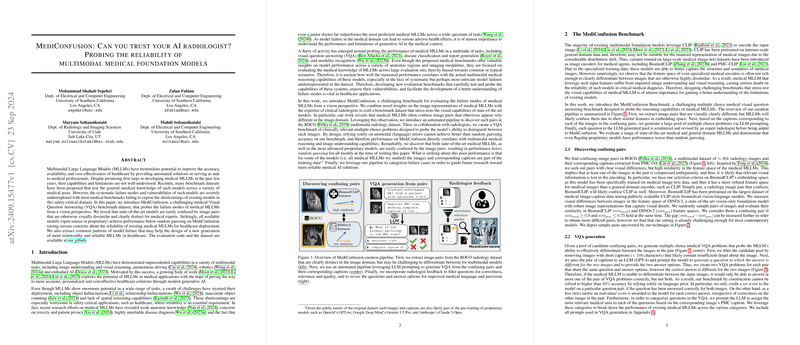MediConfusion: Can You Trust Your AI Radiologist? Probing the Reliability of Multimodal Medical Foundation Models
Overview
The paper, titled "MediConfusion: Can you trust your AI radiologist? Probing the reliability of multimodal medical foundation models," authored by Mohammad Shahab Sepehri, Zalan Fabian, Maryam Soltanolkotabi, and Mahdi Soltanolkotabi, presents an in-depth examination of the reliability of multimodal LLMs (MLLMs) in the context of medical applications. The authors introduce MediConfusion, a comprehensive and challenging visual question answering (VQA) benchmark specifically curated to test the robustness and failure modes of medical MLLMs.
Introduction
The advent of multimodal LLMs in recent years has showcased unprecedented potential in various tasks, including image understanding, visual reasoning, and more. However, despite the progressive advancements, numerous challenges persist, particularly in safety-critical domains such as healthcare. The paper highlights the lack of understanding regarding the systematic failure modes and vulnerabilities of these models when applied to medical images.
Methodology
The core of the paper is the creation of the MediConfusion benchmark. MediConfusion encompasses a set of VQA problems crafted to elucidate the inability of current state-of-the-art MLLMs to differentiate between image pairs that are visually distinct to medical experts but confusing to these models. The methodology involves:
- Image Pair Extraction: Using the ROCO dataset, the authors identified pairs of images that were visually dissimilar but appeared similar in the embedding space of BiomedCLIP, a medical variant of CLIP. This mismatch implies significant encoding ambiguities.
- VQA Problem Generation: Questions were generated for these image pairs, focusing on clinically relevant inquiries designed to be challenging without relying solely on language priors.
- Radiologist Involvement: Expert radiologists were involved to verify and refine the generated VQA problems for correctness, relevance, and precision in medical terminology.
Experiments and Results
The authors evaluated various state-of-the-art MLLMs, including both medical-specific models and general-domain proprietary models, using the MediConfusion benchmark. Key findings include:
- Performance Below Random Guessing: All evaluated models performed below random guessing accuracy on MediConfusion.
- High Confusion Scores: The models exhibited extremely high confusion rates, often selecting the same answer for both images in a pair despite the dissimilarity evident to human experts.
- No Significant Advantage for Medical MLLMs: Surprisingly, models specifically trained on medical data did not outperform general-domain models, suggesting that the specialized training did not mitigate the identified limitations effectively.
Discussion
The analysis of the results uncovered several common failure patterns:
- Normal/Variant Anatomy vs. Pathology: Difficulty distinguishing normal/variant anatomical features from pathological findings.
- Lesion Signal Characteristics: Failure to correctly identify signal intensities in radiology images, critical for distinguishing between solid and cystic entities.
- Vascular Conditions: Challenges in identifying and differentiating normal vascular structures from abnormalities such as aneurysms and occlusions.
- Medical Devices: Inability to detect and differentiate various medical devices like stents and guidewires correctly.
These observed failures align with well-known limitations of MLLMs in the general domain, such as detecting specific features, understanding state and condition, interpreting relational context, and color/appearance differentiation.
Implications and Future Work
The implications of this research are significant for both practical deployment and theoretical development of AI in healthcare. The findings raise serious concerns regarding the current readiness of MLLMs for critical medical tasks that require high reliability and precision. The identified failure patterns provide a roadmap for future research to address these limitations.
Future avenues may include improved training methodologies that better capture the nuanced features of medical images, incorporation of more rigorous evaluation benchmarks, and enhanced interpretability of the models' decision-making processes. Additionally, exploring the integration of multimodal AI with human oversight and interactive modalities, such as visual prompts, could offer paths to more robust solutions.
Conclusion
This paper provides a critical assessment of the reliability of MLLMs in medical applications through the lens of the MediConfusion benchmark. By meticulously curating a challenging dataset and involving radiology experts, the research reveals fundamental weaknesses in current models, emphasizing the need for continued efforts towards more trustworthy and reliable AI in healthcare. The MediConfusion benchmark serves as a valuable tool for the community to probe and address these critical challenges.
